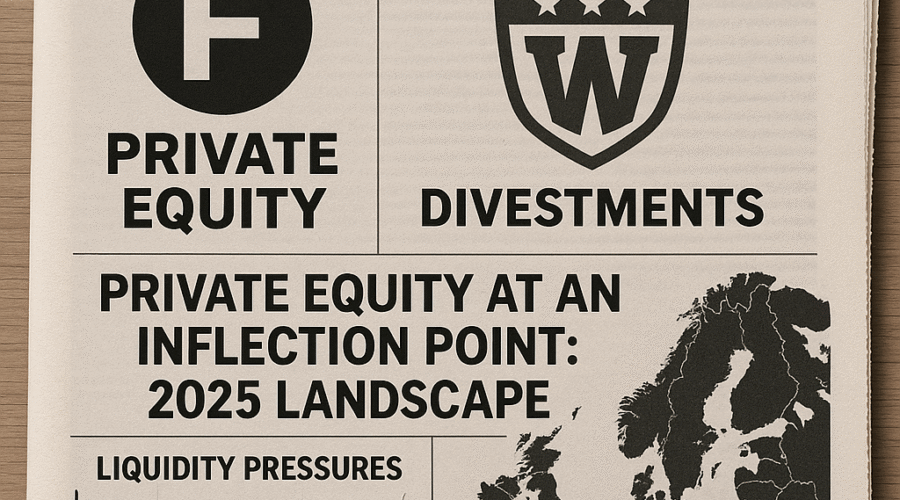As global private markets navigate post-pandemic recalibration, three seismic developments signal structural transformation: Blackstone and CVC Capital’s abrupt exit from a $12 billion NFL ownership consortium, Kuwait’s $1 trillion sovereign wealth fund demanding accelerated capital returns, and European venture capital markets demonstrating unexpected robustness through mega-deal activity. These events underscore an industry grappling with valuation mismatches, LP impatience, and strategic realignment amid shifting macroeconomic conditions.
💼 Seasoned CorpDev / M&A / PE expertise
NFL Ownership Shakeup Reveals PE Portfolio Prioritization
League Policy Shift and Consortium Breakdown
The NFL’s landmark August 2024 decision to permit private equity ownership – allowing pre-approved firms to acquire up to 10% stakes across six franchises – initially drew commitments from Blackstone, Carlyle, and CVC Capital Partners through a $12 billion consortium[1][2][15]. However, by May 2025, Blackstone and CVC unexpectedly withdrew, leaving Ares Management and Arctos Partners as primary stakeholders[14]. This reversal reflects mounting pressure on mega-funds to rationalize portfolio allocations amid scarce exit opportunities.
Strategic Implications for Sports Investments
While NFL teams generated 7.3% annualized returns exceeding the S&P 500 over the past decade[1], the split suggests diverging views on liquidity timelines. Blackstone’s $1 trillion AUM portfolio likely prioritized quicker-returning infrastructure and credit strategies over the NFL’s six-year minimum hold period[12][14]. CVC’s simultaneous $6.8 billion Asia Fund VI close and Euronext Amsterdam IPO further indicate geographic and asset class rebalancing[12][16].
Sovereign Wealth Funds Sound Alarm on PE Liquidity Crunch
Kuwait’s Warning and Secondary Market Opportunities
Kuwait Investment Authority Managing Director Sheikh Saoud Al-Sabah’s May 2025 critique – “the clock is ticking for private equity” – highlights a $2.5 trillion overhang in unrealized portfolio value[5][13]. With 30% of buyout-backed companies undergoing partial liquidity events via NAV loans or secondaries[13], sovereign funds now target distressed opportunities. This aligns with Preqin data showing secondary transaction volume surging 48% YoY to $138 billion in Q1 2025.
LP Allocation Pressures Intensify
Pension funds face acute liquidity constraints, with average PE allocations at 12.7% versus 10% policy targets[16]. Harvard Management Company’s 39% PE exposure exemplifies the “denominator effect” crippling new commitments[17]. Bain analysis reveals distributions covering just 78% of capital calls since 2020, creating a $210 billion funding gap[13].
European Venture Capital Defies Macro Headwinds
Q1 2025 Market Dynamics
European VC investment held steady at $18 billion despite 18.6% fewer deals, signaling concentration in later-stage rounds[6][7]. Five $500M+ mega-deals dominated, including a $1.1 billion Series G for a German AI-driven logistics platform and $850 million growth round for a French climate tech unicorn[11]. The UK retained leadership with $5.5 billion raised, though Germany’s 41% YoY increase to $2.2 billion suggests shifting geographic priorities[6].
| Sector | Deal Value | YoY Change |
|---|---|---|
| Climate Tech | $2.9B | +26% |
| Artificial Intelligence | $1.7B | +39% |
| Fintech | $1.48B | -12% |
Valuation Discipline and Exit Challenges
Median pre-money valuations reached $95 million for Series B rounds, a 22% increase from 2024[7]. However, exit value fell 31% YoY to $4.2 billion, with just two IPOs exceeding $500 million[11]. This dichotomy pressures firms like Index Ventures and Balderton Capital to extend hold periods beyond traditional 5-7 year horizons.
Fundraising Slump Accelerates Market Consolidation
Capital Concentration Trends
Private equity fundraising plunged 18.6% to $487.7 billion in 2024, with the top 20 firms capturing 63% of capital[16]. Mega-funds (>$5B) now account for 58% of closed vehicles versus 42% pre-pandemic[3]. This bifurcation leaves mid-market managers struggling – only 23% of sub-$1 billion funds reached target sizes in 2024 versus 61% in 2021[9].
Alternative Liquidity Solutions Gain Traction
With traditional exits covering just 34% of maturing investments, GPs increasingly utilize NAV facilities (up 57% YoY to $89 billion) and GP-led secondaries (42% of all PE exits)[4][13]. CVC’s $6.8 billion Asia Fund VI incorporates a dedicated $1.2 billion continuation vehicle sleeve, reflecting structural adaptation to LP demands[12].
Strategic Imperatives for Private Capital Leaders
Operational Value Creation Intensifies
Bain’s analysis shows top-quartile funds generate 73% of returns through operational improvements versus 41% for median performers[13]. This gap drives demand for sector-specific operating partners – Blackstone’s recent hiring of 24 industrial experts underscores the trend.
Regulatory and Geopolitical Risk Mitigation
With 68% of LPs citing regulatory scrutiny as a top concern, firms like Carlyle now embed compliance teams in due diligence phases[4]. The EU’s Foreign Subsidies Regulation has already impacted 23% of cross-border deals, necessitating advanced screening protocols[7].
Conclusion: Navigating the New Private Markets Reality
The confluence of NFL consortium withdrawals, sovereign fund activism, and European VC resilience paints a complex picture for 2025. Successful firms will balance liquidity innovation (secondaries, NAV lending) with sector-specific operational expertise, while LPs must reconcile return expectations with elongated hold periods. As KIA’s Al-Sabah noted, the era of “financial engineering alpha” has ended – sustainable value creation now demands strategic reinvention.
Sources





